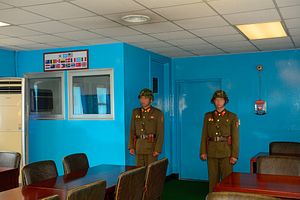The 2015 defense white paper, compiled by the Japanese Ministry of Defense titled “Defense of Japan 2015,” highlights Tokyo’s growing concern over the radicalization of North Korea’s military in the face of Kim Jong-un’s personnel politics, including the dismissal of a number of senior military officers and the execution of Vice-Chairman Jang Song-thaek.
“This in turn could propel North Korea to turn to military provocative actions without making sufficient diplomatic considerations. Accordingly, uncertainty is deemed to be rising,” the paper reads. The execution of Jang Song-thaek, in particular, has been seen as victory for North Korean military hardliners and advocates of the continuation of the country’s “military first” policy.
Looking at North Korea’s ballistic missile program, the white paper emphasizes that Pyongyang – heavily investing into research and development as well as increasing its general operational capabilities – is progressively more capable of surprise launches, which as a corollary increases the overall missile threat for Japan. “North Korea’s ballistic missile issue has become more realistic and imminent for Northeast Asia, including Japan, and for the international community from the perspective of both the improvement of the capability and transfer and proliferation, and such developments are profoundly worrisome,” the publication notes.
The report is adamant that Pyongyang’s nuclear weapons development “poses a grave threat to Japan’s security and significantly impairs peace and stability in Northeast Asia and the international community. Therefore, they can never be tolerated.” However, the paper does not elaborate what specific policies Japan’s non-toleration of North Korea’s nuclear weapons would entail. The paper just calls for a close monitoring of all related developments in this field.
While noting that most of the Korean People’s Army (KPA) equipment is outdated, the defense white papers explains that North Korea is gradually building up its military capabilities in accordance with its so-called Four Military Guidelines: extensive training for all soldiers, modernizing all military forces, arming the entire population, and fortifying the entire country.
However, the publication notes that Pyongyang’s conventional forces “are considerably inferior to those of the ROK and the U.S. Forces Korea” with the unfortunate consequence that North Korea will increase its “efforts on WMD and ballistic missile reinforcements in order to compensate for this shortfall.”
The overall issue when trying to analyze North Korea’s regime as well as its military capabilities is that it is often educated guesswork as the paper admits, particularly when it comes to progress on nuclear weapons: “Details of the current status of North Korea’s nuclear weapons program are largely unclear, partly because North Korea remains an extremely closed regime.”

































